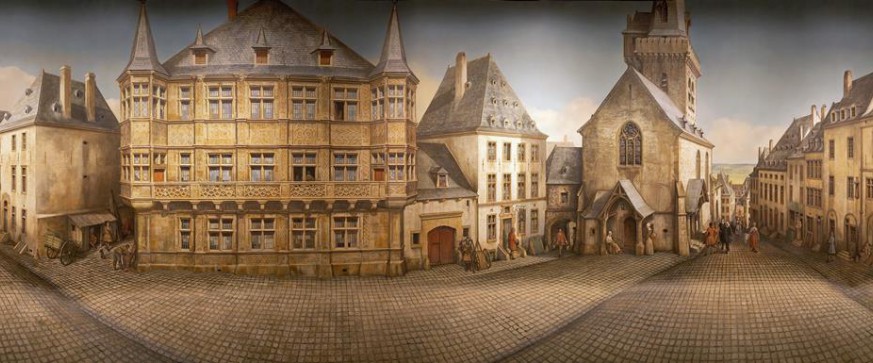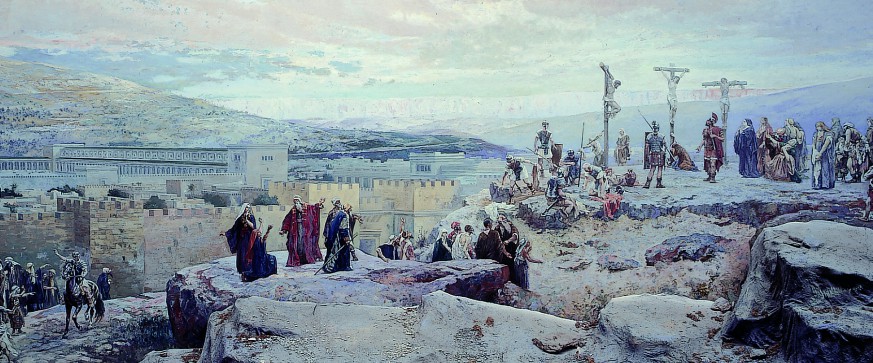The participants of the 23rd Conference in Altötting were already treated by the amazing talk of Ralph Hyde on his Paper Peepshows. His book is now for sale via the Antique Collectors’ Club with ISBN 9781851498000. With its 272 pages and 511 color illustrations it is definitely a book that you want to have.
- Panorama Rouen 1431
created by Yadegar Asisi in 2016
photo © asisi.jpg)
- Panorama Rotunda by Hittdorf
Paris, France in 1838 - Panorama of the Entry of the Magyars / Feszty-Panorama
Opusztaszer, Hungary
© Patrick Deicher - The City of Luxembourg in the 17th century (Artist: Antoine Fontaine)
Musée d'histoire de la Ville de Luxembourg, Luxembourg
© MHVL, Falk Eisleben
- Semi-circle Panorama 'The Berlin Wall' created in 2012 by Yadegar Asisi, © asisi, Tom Schulze
.jpg)
- e-cyclorama by Sanford Wurmfeld
exhibited in Edinburgh, Scotland in 2008.jpg)
- Jerusalem Panorama Crucifixion of Christ, Altötting, Germany, © Stiftung Panorama Altötting / photo H. Heine
.jpg)
- Wilpena Panorama created by Jeffrey B. Morgan, Hawker, Australia
- Diorama of the Conquest of Constantinople in 1453
Military Museum, Istanbul, Turkey
© Patrick Deicher - ICCI 360 Rotunda
seamless 360° film projection in a mobile rotunda
ICCI (Innovation for the Creative and Cultural Industries) with Plymouth University, UK
© Patrick Deicher.jpg)
- Panorama of Jerusalem and the Crucifixion of Christ, Einsiedeln, Switzerland

- Panorama Raclawice
Wroclaw, Poland
© Patrick Deicher
- Panorama of The Battle of Waterloo
Braine l'Alleud, Belgium
© Patrick Deicher.jpg)
- Interactive electronic panorama
exhibited in Luzern, Switzerland in 2010
© Patrick Deicher.jpg)
- Panorama of the City of Salzburg (Sattler-Panorama)
Salzburg, Austria
- Panorama of the Palace and Gardens of Versailles
Metropolitan Museum of Art, New York, USA
© Patrick Deicher
- Panorama of the Chibi War in 208
Wuhan, China
- Panorama of the Battle of Pleven
Pleven, Bulgaria
© Patrick Deicher
- Panorama of the Battle of Ji Nan
Ji Nan, China
- Panorama of the Battle of Mount Isel
TirolPanorama, Innsbruck, Austria
© Patrick Deicher
- Bourbaki Panorama
Luzern, Switzerland
© Emanuel Ammon.jpg)
- News
Paper Peepshows The Jaqueline & Jonathan Gestetner Collection
Thursday, 25 December 2014Peepshows were introduced in the mid-eighteenth century by Martin Engelbrecht in Augsburg. They called for a long wooden cabinet designed for purpose incorporating a viewing lens and sometimes a mirror. In the 1820s peepshows made entirely of paper appeared on the scene more or less at the same moment in Vienna, London and Paris. The clumsy cabinet was no longer called for. The new peepshow was equipped with paper bellows so it could be expanded or contracted in a trice. Paper peepshows were light; they were comparatively cheap. They fitted neatly into the pocket. Viewing a Paper Peepshow is an intimate, individual experience that, in the age of television and hand-held computers, gives a real sense of personal discovery. The viewer engages by peeping through a tiny hole and thereby discovers inside layers of images, like a pocket-sized stage set.
The format lent itself to a wide variety of subjects: to coronations and to state visits and funerals, to pleasure gardens, to trips up rivers and to the ceremonial openings of new railways, to distant views of cities and to tourist landmarks, to military engagements in exotic places, and to the July Revolution and the fall of the Bourbons in France in 1830. The Crystal Palace, erected in Hyde Park 1851 for the Great Exhibition, inspired the production of very large numbers of peepshows, mostly made overseas and imported. Peepshows made possible visits to sites existing in the imagination, to plunge down Alice's rabbit hole, for example, and to wander through the Garden of Eden in Paradise.
The main center of peepshow manufacture in the nineteenth century was toy-making Nuremburg. Briefly in the 1950s it was Britain. Nowadays it is the United States. Paper peepshows are no longer intended essentially for children but for bibliophiles and art-appreciating adults.
This stunning book charts the history of these charming collectables. The illustrated catalogue section includes the following data where known: country of origin, publisher, date, method of printing (eg chromolithograph), shape and dimensions, and number of scenes. As well as a full description of each piece, the author gives fascinating historical and cultural context for these items - ranging from depictions of the July Revolution (Paris, 1830), or the opening of the Thames Tunnel to the nursery tale of 'Puss in Boots'.
Contents: Foreword by Erkki Huhtamo (Prof. in the dept of Design Media Arts, University of California; Preface by Julius Bryant, Keeper of Word and Image, V&A; The Story of paper Peepshows; What we peep with; Austria; Canada; China; Denmark; France; Germany; Great Britain; Italy; Russia; The Netherlands; United States of America; Unknown Origin; Peepshow view boxes; Table-top Tableaux.

.jpg)